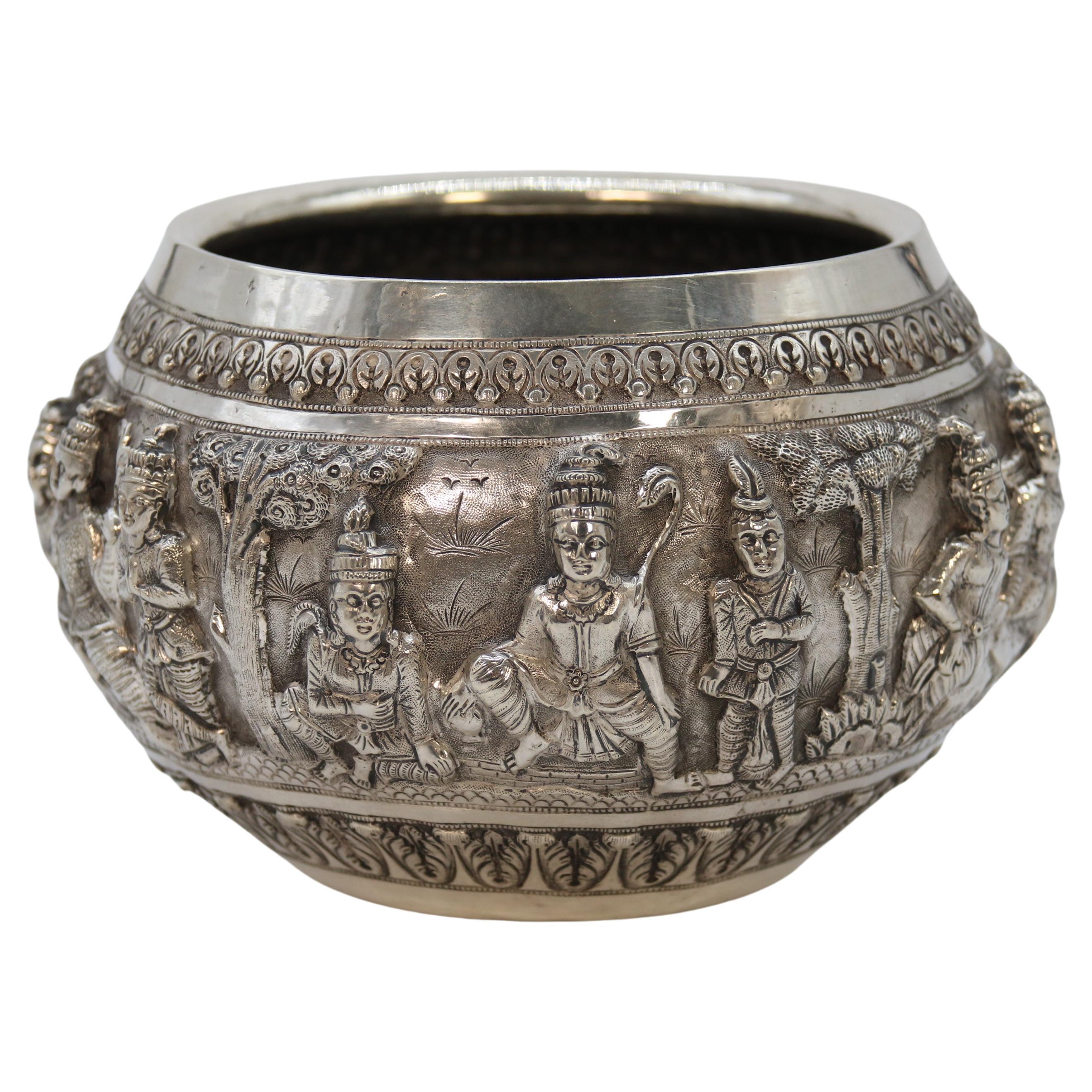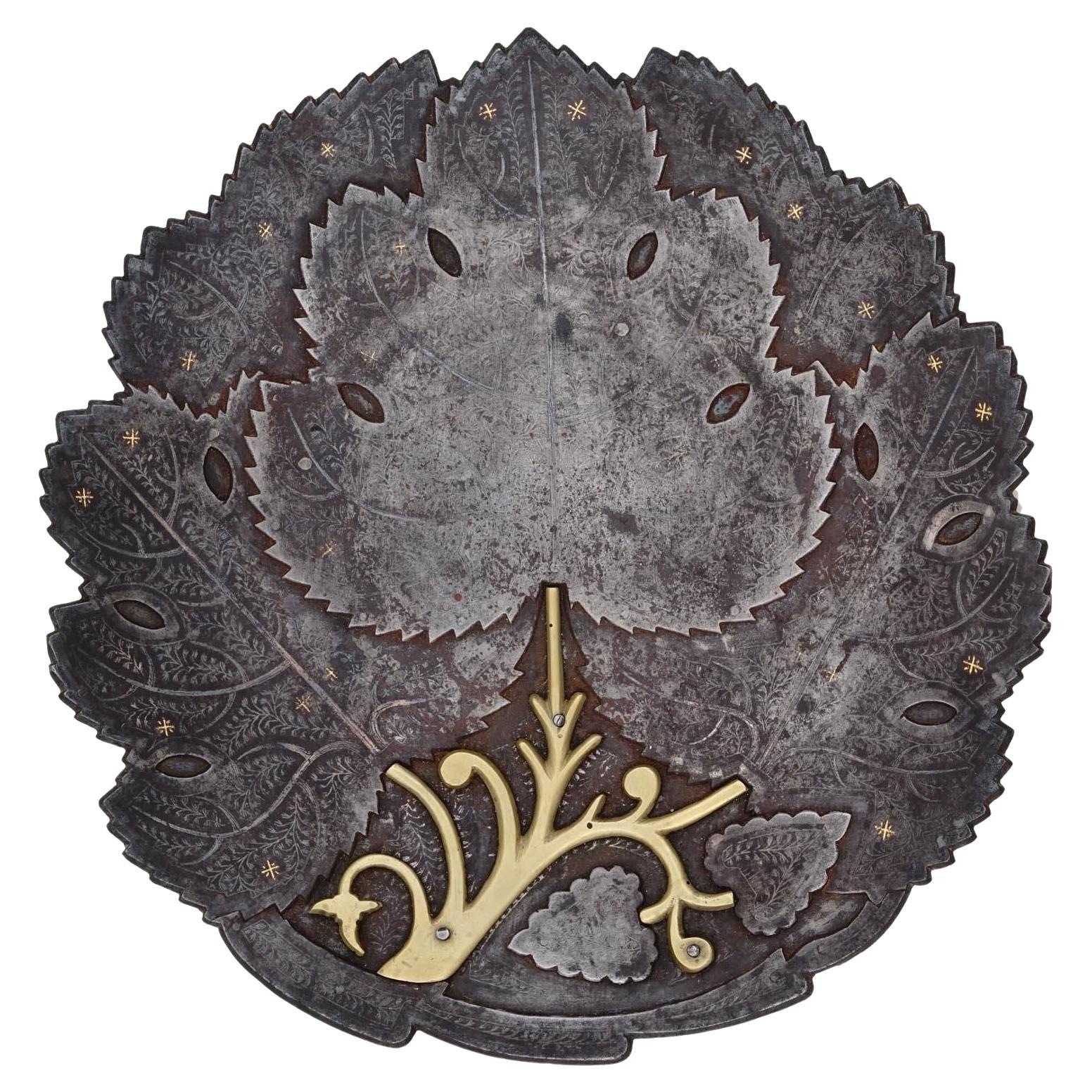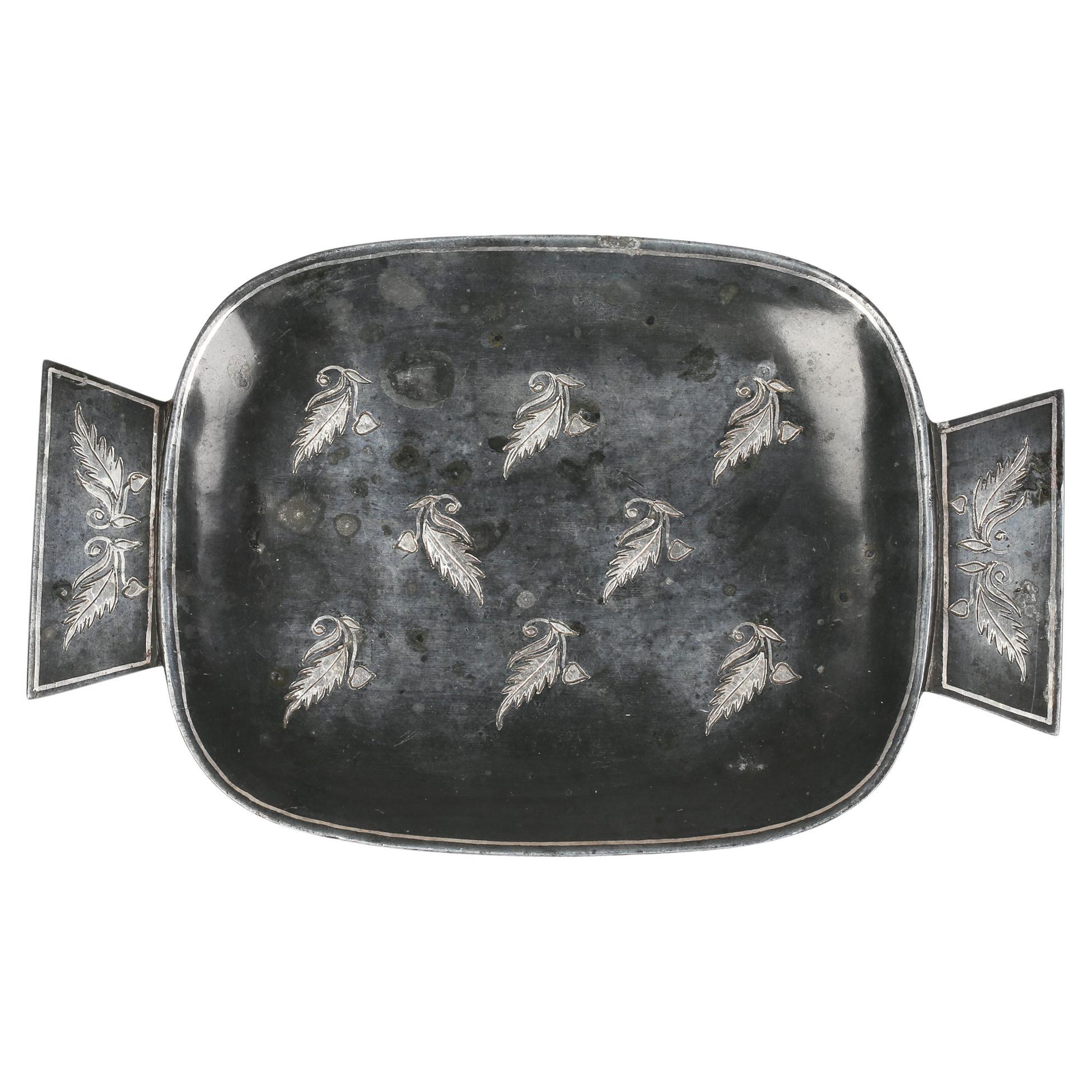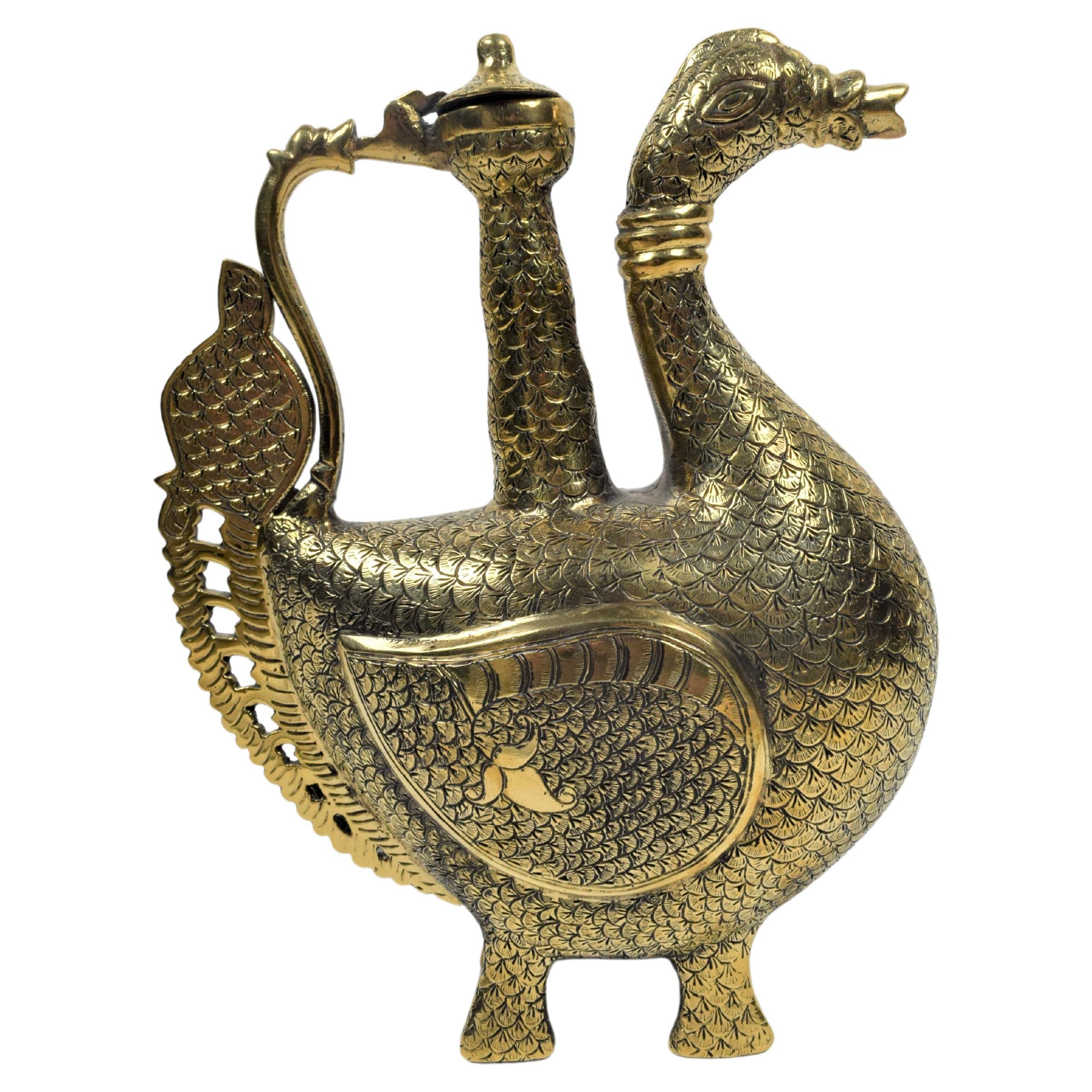Items Similar to A 19th century Indian silver inlaid dagger with a Damascus steel blade, C 1870
Want more images or videos?
Request additional images or videos from the seller
1 of 10
A 19th century Indian silver inlaid dagger with a Damascus steel blade, C 1870
About the Item
A fine 19th-century ornate Indian dagger superbly made from hand forged folded steel known as Damascus which shows on the blade with a pattern almost like wood grain.
The whole knife is made from solid steel and the handle is most elaborate with a curved grip which terminates in a tiger’s head all of which is profusely inlaid with finely cut silver in foliate patterns and panels with realistic markings to the tiger's head.
This fine and interesting antique knife would be a good addition to any collection or would be very useful on a desk as a paper or letter opening knife.
Some history on the Damascus steel:
The history of Damascus steel can be traced all the way back to 500 A.D. when in India it was called Telangana, Wootz or Ukku steel. It then found its way to Damascus, Syria, which was the centre of trade in that region for war equipment such as knives, swords and armour. The name “Damascus” wasn’t adopted until the time of the Crusaders. The Crusaders witnessed Damascus swords slicing through their own lesser quality swords, cutting the sword clean in half in a single swipe without ever losing its edge. The next swipe would do the same to the body of that less fortunate Crusader.
Historians believe that the original method for creating Damascus was the crucible method. The crucible method of production for original ancient Damascus steel gradually declined, ceasing by around 1750, and the process was lost to metal smiths.
Indian, circa 1870
Height 5cm x width 26cm x depth 2cm
- Dimensions:Height: 1.97 in (5 cm)Width: 10.24 in (26 cm)Depth: 0.79 in (2 cm)
- Style:Anglo Raj (Of the Period)
- Materials and Techniques:
- Place of Origin:
- Period:
- Date of Manufacture:1870
- Condition:
- Seller Location:Central England, GB
- Reference Number:1stDibs: LU6434238577062
About the Seller
No Reviews Yet
Vetted Seller
These experienced sellers undergo a comprehensive evaluation by our team of in-house experts.
Established in 1984
1stDibs seller since 2022
14 sales on 1stDibs
Typical response time: 11 hours
- ShippingRetrieving quote...Ships From: Central England, United Kingdom
- Return PolicyA return for this item may be initiated within 14 days of delivery.
More From This SellerView All
- 19th century Indian silver Raj period deep relief repousse work bowl circa 1870Located in Central England, GBThis very high quality piece of impressive Raj period Indian silver is superbly decorated with three dimensional deep relief repousse work in the form of traditional male and female...Category
Antique Late 19th Century Indian Other Metalwork
MaterialsSilver
- A Raj period silver, copper and brass repousse work charger, Indian circa 1900Located in Central England, GBThis very fine quality late 19th century Raj period charger is made from heavy gauge brass which is extensively hand decorated with exceptionally fin...Category
Early 20th Century Indian Anglo Raj Metalwork
MaterialsSilver, Brass, Copper
- 19th century Chinese bronze cencer with Buddhist lion decoration circa 1860Located in Central England, GBThis large Chinese bronze censer dates to circa 1860. It is made in three parts, stand, vessel, and lid. The lid has pierced decorative panels with pine trees and a bold Buddhist lion finial for lifting. The censer has lifting handles in the shape of bamboo to each side and again also has panels with pine forests with mythical beasts and side mounts in the form of Buddhist lion mastheads. It is raised on four shaped legs with a beast mask head at the top and sits on the raised and pierced stand. The decoration on this piece is all hand finished with chasing and engraving giving good detail. The censer has a green/brown patina. Circa 1860 Censers are a type of vessel for burning incense. In many cultures burning incense has spiritual and religious connotations which influence the design and decoration of the censer. The lion is one of Buddhism’s most potent symbols. Traditionally the lion is associated with regality, strength and power. It is therefore an appropriate symbol of Buddha who, tradition has it, was a regal prince. As Buddhist priests and monks from India, they brought with them stories of stone Asiatic lions...Category
Antique Mid-19th Century Chinese Chinese Export Metalwork
MaterialsBronze
- 19th Century Indian Raj Period Copper and Brass Plaque circa 1880Located in Central England, GBA 19th C Indian Raj Period Plaque This finely crafted raised and chased Indian Raj period copper and brass plaque has an intricately worked central panel depicting Nataraga, the g...Category
Antique 19th Century Indian Anglo Raj Decorative Art
MaterialsCopper
- Antique pair of mid 19th century Raj period Indian ceremonial bowls circa 1860Located in Central England, GBThis highly decorative pair of mid 19th century Raj period Indian ceremonial bowls is very unusual. They are made from dense red hardwood turned by hand on a simple pole lathe and th...Category
Antique 19th Century Indian Anglo Raj Decorative Bowls
MaterialsBrass
- Early 20th Century Inlaid Hardwood Anglo Indian Collectors ChestLocated in Central England, GBEarly 20th Century Inlaid Hardwood Anglo Indian Collectors Chest This small collector’s chest of drawers is very pleasing to the eye. It is constructed in a red hardwood which is he...Category
20th Century Indian Anglo-Indian Commodes and Chests of Drawers
MaterialsHardwood
You May Also Like
- Pair of Metal Mughal Horse Stirrups with Silver Inlay, 19th CenturyLocated in Islamabad, PKThepair of metal Mughal horse stirrups with silver inlay, dating back to the 19th century, are astriking example of equestrian equipment reflecting the ar...Category
Antique 19th Century Indian Anglo Raj Metalwork
MaterialsMetal, Silver
- 19th Century Anglo Indian Solid Silver small Bowl hand made with chased DietiesLocated in Lincoln, LincolnshireThis is a solid silver Anglo-Indian bowl decorated with seated Dieties and made in India in the late 19th century, circa 1880. The small circular bowl is made of solid silver and has a low foot. The bowl has been beautifully hand chased with seated Dieties in different poses within circular panels which form a continuous pattern around the bowl set between a flower and leaf motif, with a lower border below the figures. The bowl weighs 79 gram. Overall, a beautiful antique solid silver bowl.Category
Antique 19th Century Indian Anglo-Indian Metalwork
MaterialsSilver
- 19th Century Indo-Persian Silver Inlaid and Parcel Gilt Steel and Brass DishLocated in New York, NYFine antique (19th century) Indo-Persian steel dish or salver in the form of overlapping grape leaves with damascene and koftgari silver inlay and gilded designs and brass overlay re...Category
Antique Late 19th Century Indian Metalwork
MaterialsCut Steel
- Indian Silver Bidriware Inlaid Silver Metal Twin Handled TrayLocated in Bishop's Stortford, HertfordshireA fine antique Indian Bidriware twin handled tray inlaid with silver leaf designs and dating from the latter 19th century. The tray stands raised on rectangular shaped foot and is of...Category
Antique Late 19th Century Indian Anglo-Indian Metalwork
MaterialsMetal, Silver
- Mughal Brass Peacock Engraved Ewer, Late 19th CenturyLocated in Islamabad, PKThe ewer, a ceremonial pitcher, is shaped in the form of a majestic peacock, a significant motif in Mughal art symbolizing beauty, grace, and regality. The body of the ewer is crafte...Category
Antique Late 19th Century Indian Anglo Raj Metalwork
MaterialsBrass
- Mughal Brass Peacock Engraved Ewer, Late 19th CenturyLocated in Islamabad, PKThe ewer, a ceremonial pitcher, is shaped in the form of a majestic peacock, a significant motif in Mughal art symbolizing beauty, grace, and regality. The body of the ewer is crafte...Category
Antique Late 19th Century Indian Anglo Raj Metalwork
MaterialsBrass
Recently Viewed
View AllMore Ways To Browse
Burmese Brass Fish
Hindu Brass Fish
Decorative Wall Plate With Silver And Copper Inlays
Cairoware Tray
Indo Persian Large Water Vessels
Leather Chair Set Of 2 Midcentury
Murano Round Art Glass Midcentury
French Kingwood And Marble Cabinet
Column Capital Base
1890s Head
1920 Entry Doors
Coffee Table With Brass Accents
Marble Table Set Of 2
French Leather Top Wood Desk
Vintage Silver Fruit
South African Designers
Antique Wooden Entry Table
18th Century Hook





